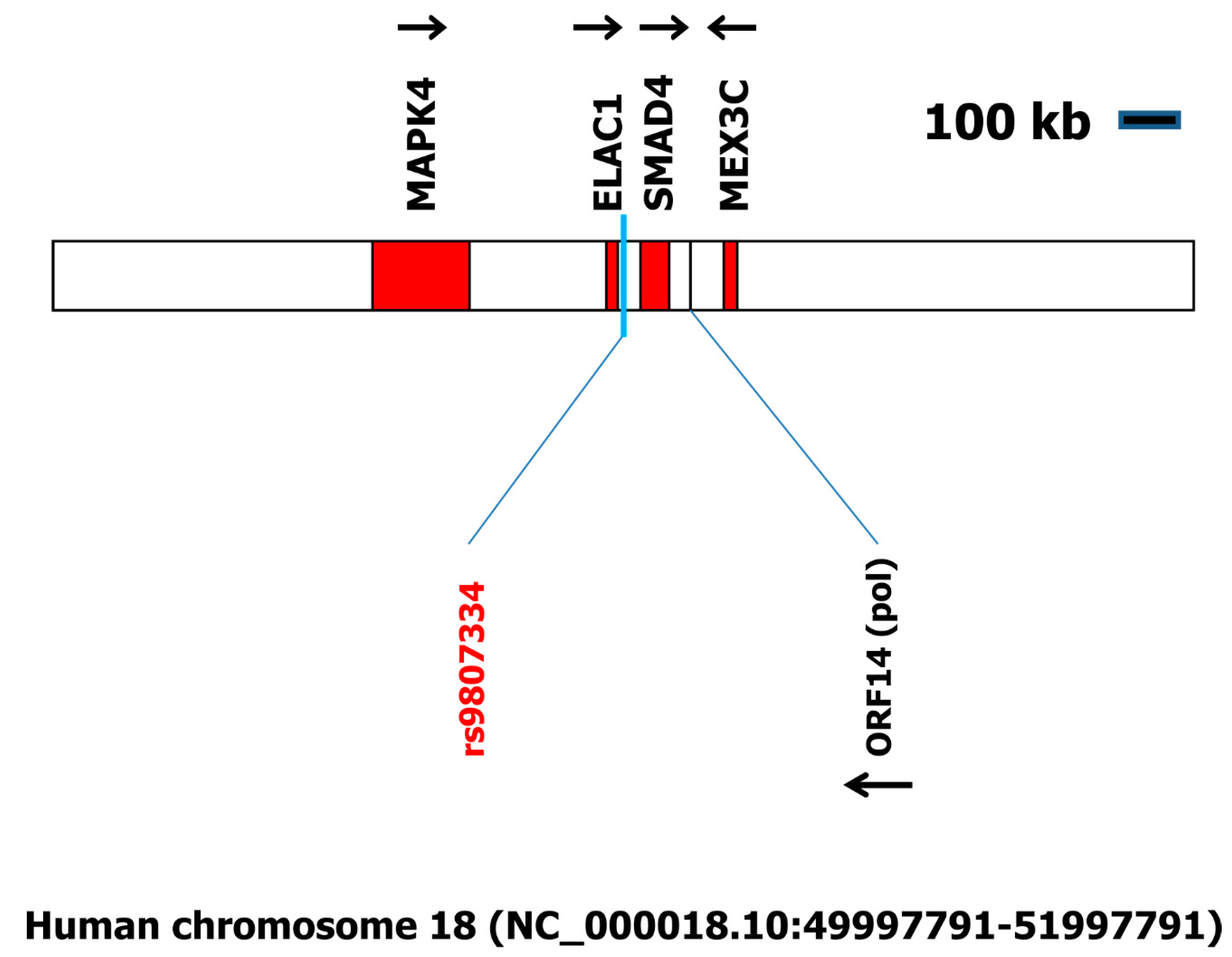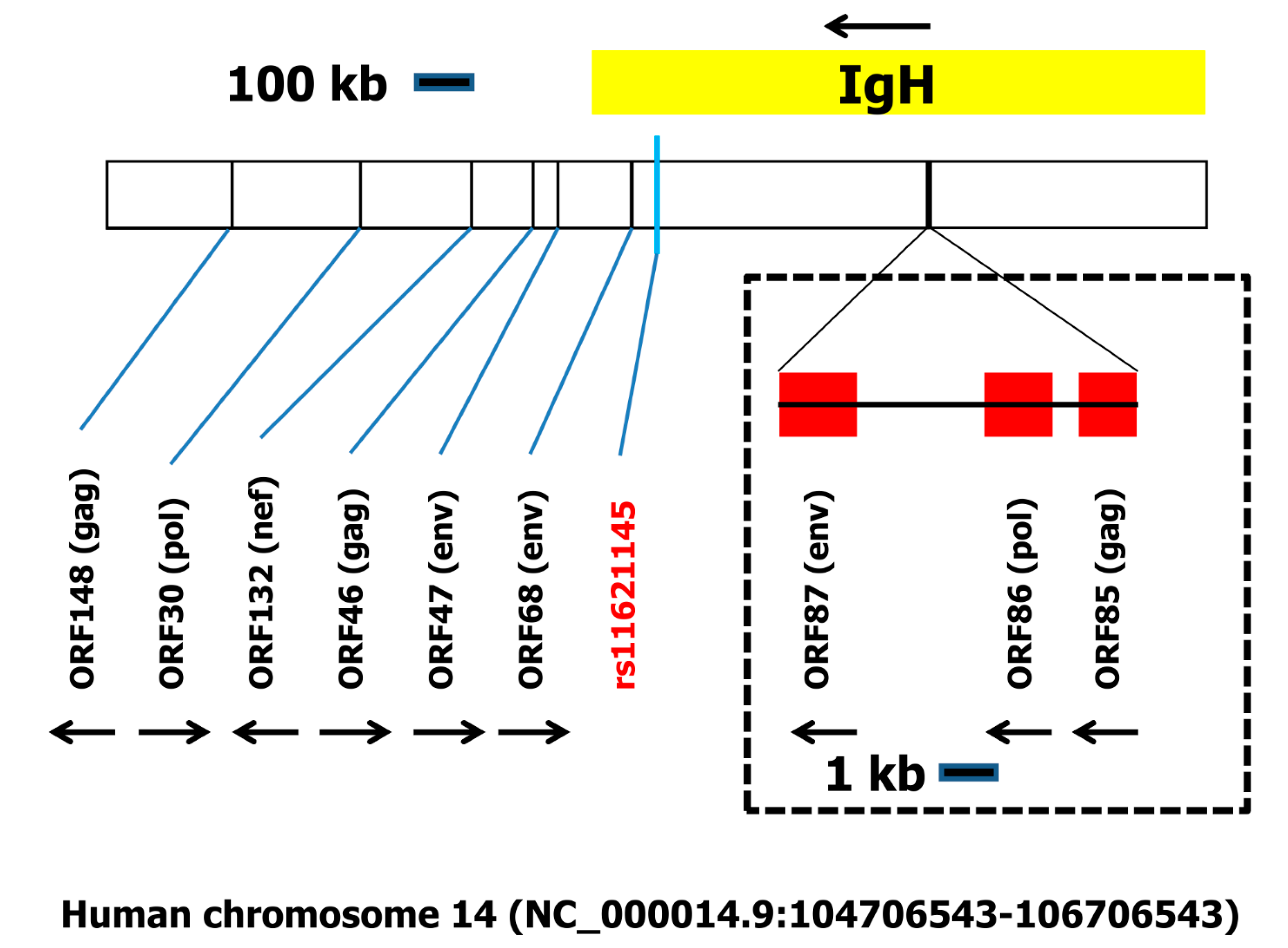Genetic Determinants of Antibody Levels in Cerebrospinal Fluid in Multiple Sclerosis: Possible Links to Endogenous Retroviruses
Abstract
:1. Introduction
2. Results
3. Discussion
4. Materials and Methods
5. Conclusions
Supplementary Materials
Acknowledgments
Author Contributions
Conflicts of Interest
References
- Thompson, A.J.; Banwell, B.L.; Barkhof, F.; Carroll, W.M.; Coetzee, T.; Comi, G.; Correale, J.; Fazekas, F.; Filippi, M.; Freedman, M.S.; et al. Diagnosis of multiple sclerosis: 2017 revisions of the McDonald criteria. Lancet Neurol. 2017, 17, 162–173. [Google Scholar] [CrossRef]
- Skotzek, B.; Sander, T.; Zimmermann, J.; Kölmel, H.W. Oligoclonal bands in serum and cerebrospinal fluid of patients with HIV infection. J. Neuroimmunol. 1988, 20, 151–152. [Google Scholar] [CrossRef]
- Hall, C.D.; Snyder, C.R.; Robertson, K.R.; Messenheimer, J.A.; Wilkins, J.W.; Robertson, W.T.; Whaley, R.A.; Van der Horst, C.; Silverman, L.M. Cerebrospinal fluid analysis in human immunodeficiency virus infection. Ann. Clin. Lab. Sci. 1992, 22, 139–143. [Google Scholar] [PubMed]
- Kammer-Suhr, B.; Heese, C.; Kulschewski, A.; Reichelt, D.; Evers, S.; Husstedt, I.W. Cerebrospinal fluid parameters in various stages of HIV infection. Results of cross-sectional and longitudinal analysis. Der Nervenarzt 2003, 74, 677–682. [Google Scholar] [PubMed]
- Goris, A.; Pauwels, I.; Gustavsen, M.W.; van Son, B.; Hilven, K.; Bos, S.D.; Celius, E.G.; Berg-Hansen, P.; Aarseth, J.; Myhr, K.M.; et al. Genetic variants are major determinants of CSF antibody levels in multiple sclerosis. Brain 2015, 138, 632–643. [Google Scholar] [CrossRef] [PubMed]
- Emmer, A.; Staege, M.S.; Kornhuber, M.E. The retrovirus/superantigen hypothesis of multiple sclerosis. Cell. Mol. Neurobiol. 2014, 34, 1087–1096. [Google Scholar] [CrossRef] [PubMed]
- Brütting, C.; Emmer, A.; Kornhuber, M.; Staege, M.S. A survey of endogenous retrovirus (ERV) sequences in the vicinity of multiple sclerosis (MS)-associated single nucleotide polymorphisms (SNPs). Mol. Biol. Rep. 2016, 43, 827–836. [Google Scholar] [CrossRef] [PubMed]
- Perron, H.; Garson, J.A.; Bedin, F.; Beseme, F.; Paranhos-Baccala, G.; Komurian-Pradel, F.; Mallet, F.; Tuke, P.W.; Voisset, C.; Blond, J.L.; et al. Molecular identification of a novel retrovirus repeatedly isolated from patients with multiple sclerosis. The Collaborative Research Group on Multiple Sclerosis. Proc. Natl. Acad. Sci. USA 1997, 94, 7583–7588. [Google Scholar] [CrossRef] [PubMed]
- Bush, W.S.; Moore, J.H. Chapter 11: Genome-wide association studies. PLoS Comput. Biol. 2012, 8, e1002822. [Google Scholar] [CrossRef] [PubMed]
- Laufer, G.; Mayer, J.; Mueller, B.F.; Mueller-Lantzsch, N.; Ruprecht, K. Analysis of transcribed human endogenous retrovirus W env loci clarifies the origin of multiple sclerosis-associated retrovirus env sequences. Retrovirology 2009, 6, 37. [Google Scholar] [CrossRef] [PubMed]
- Venter, J.C.; Adams, M.D.; Myers, E.W.; Li, P.W.; Mural, R.J.; Sutton, G.G.; Smith, H.O.; Yandell, M.; Evans, C.A.; Holt, R.A.; et al. The sequence of the human genome. Science 2001, 291, 1304–1351. [Google Scholar] [CrossRef] [PubMed]
- Medstrand, P.; Mager, D.L.; Yin, H.; Dietrich, U.; Blomberg, J. Structure and genomic organization of a novel human endogenous retrovirus family: HERV-K (HML-6). J. Gen. Virol. 1997, 78, 1731–1744. [Google Scholar] [CrossRef] [PubMed]
- Turner, G.; Barbulescu, M.; Su, M.; Jensen-Seaman, M.I.; Kidd, K.K.; Lenz, J. Insertional polymorphisms of full-length endogenous retroviruses in humans. Curr. Biol. 2001, 11, 1531–1535. [Google Scholar] [CrossRef]
- Moyes, D.L.; Martin, A.; Sawcer, S.; Temperton, N.; Worthington, J.; Griffiths, D.J.; Venables, P.J. The distribution of the endogenous retroviruses HERV-K113 and HERV-K115 in health and disease. Genomics 2005, 86, 337–341. [Google Scholar] [CrossRef] [PubMed]
- Krzysztalowska-Wawrzyniak, M.; Ostanek, M.; Clark, J.; Binczak-Kuleta, A.; Ostanek, L.; Kaczmarczyk, M.; Loniewska, B.; Wyrwicz, L.S.; Brzosko, M.; Ciechanowicz, A. The distribution of human endogenous retrovirus K-113 in health and autoimmune diseases in Poland. Rheumatology (Oxford) 2011, 50, 1310–1314. [Google Scholar] [CrossRef] [PubMed]
- Moyes, D.L.; Goris, A.; Ban, M.; Compston, A.; Griffiths, D.J.; Sawcer, S.; Venables, P.J. HERV-K113 is not associated with multiple sclerosis in a large family-based study. AIDS Res. Hum. Retrovir. 2008, 24, 363–365. [Google Scholar] [CrossRef] [PubMed]
- Nexø, B.A.; Christensen, T.; Frederiksen, J.; Møller-Larsen, A.; Oturai, A.B.; Villesen, P.; Hansen, B.; Nissen, K.K.; Laska, M.J.; Petersen, T.S.; et al. The etiology of multiple sclerosis: Genetic evidence for the involvement of the human endogenous retrovirus HERV-Fc1. PLoS ONE 2011, 6, e16652. [Google Scholar] [CrossRef] [PubMed]
- Boon, M.; Nolte, I.M.; De Keyser, J.; Buys, C.H.; te Meerman, G.J. Inheritance mode of multiple sclerosis: The effect of HLA class II alleles is stronger than additive. Hum. Genet. 2004, 115, 280–284. [Google Scholar] [CrossRef] [PubMed]
- Patke, C.L.; Shearer, W.T. Gp120- and TNF-alpha-induced modulation of human B cell function: Proliferation, cyclic AMP generation, Ig production, and B-cell receptor expression. J. Allergy Clin. Immunol. 2000, 105, 975–982. [Google Scholar] [CrossRef] [PubMed]
- Bonnan, M.; Barroso, B.; Demasles, S.; Krim, E.; Marasescu, R.; Miquel, M. Compartmentalized intrathecal immunoglobulin synthesis during HIV infection—A model of chronic CNS inflammation? J. Neuroimmunol. 2015, 285, 41–52. [Google Scholar] [CrossRef] [PubMed]
- Altschul, S.F.; Wootton, J.C.; Gertz, E.M.; Agarwala, R.; Morgulis, A.; Schäffer, A.A.; Yu, Y.K. Protein database searches using compositionally adjusted substitution matrices. FEBS J. 2005, 272, 5101–5109. [Google Scholar] [CrossRef] [PubMed]
- Rice, P.; Longden, I.; Bleasby, A. EMBOSS: The European Molecular Biology Open Software Suite. Trends Genet. 2000, 16, 276–277. [Google Scholar] [CrossRef]




© 2018 by the authors. Licensee MDPI, Basel, Switzerland. This article is an open access article distributed under the terms and conditions of the Creative Commons Attribution (CC BY) license (http://creativecommons.org/licenses/by/4.0/).
Share and Cite
Emmer, A.; Brütting, C.; Kornhuber, M.; Staege, M.S. Genetic Determinants of Antibody Levels in Cerebrospinal Fluid in Multiple Sclerosis: Possible Links to Endogenous Retroviruses. Int. J. Mol. Sci. 2018, 19, 786. https://doi.org/10.3390/ijms19030786
Emmer A, Brütting C, Kornhuber M, Staege MS. Genetic Determinants of Antibody Levels in Cerebrospinal Fluid in Multiple Sclerosis: Possible Links to Endogenous Retroviruses. International Journal of Molecular Sciences. 2018; 19(3):786. https://doi.org/10.3390/ijms19030786
Chicago/Turabian StyleEmmer, Alexander, Christine Brütting, Malte Kornhuber, and Martin S. Staege. 2018. "Genetic Determinants of Antibody Levels in Cerebrospinal Fluid in Multiple Sclerosis: Possible Links to Endogenous Retroviruses" International Journal of Molecular Sciences 19, no. 3: 786. https://doi.org/10.3390/ijms19030786





